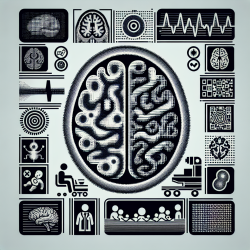Introduction
As a Special Education Director, staying informed about the latest research is crucial for enhancing the educational strategies and therapeutic interventions for students with unique needs. The study "Brain Morphological Abnormalities in 49,XXXXY Syndrome: A Pediatric Magnetic Resonance Imaging Study" provides valuable insights into the neuroanatomical characteristics of individuals with 49,XXXXY syndrome, a rare sex chromosome aneuploidy. This blog explores the study's findings and discusses how practitioners can apply this knowledge to improve educational and therapeutic outcomes for affected students.
Key Findings of the Study
The research conducted by Blumenthal et al. (2013) utilized magnetic resonance imaging (MRI) to examine brain morphometry in 14 youth with 49,XXXXY syndrome compared to 42 age-matched healthy controls. The study revealed several significant findings:
- Reduced Brain Size: Individuals with 49,XXXXY syndrome exhibited a significantly smaller total brain size compared to controls.
- Increased Brain Abnormalities: Higher rates of brain abnormalities, including colpocephaly, plagiocephaly, and periventricular cysts, were observed.
- White Matter Lesions: White matter lesions were identified in 50% of subjects, indicating potential adverse effects on white matter development.
- Corpus Callosum Abnormalities: A smaller cross-sectional area of the corpus callosum was noted, suggesting disruptions in interhemispheric communication.
Implications for Practitioners
The findings from this study offer critical insights that can guide practitioners in tailoring interventions for students with 49,XXXXY syndrome. Here are some practical applications:
- Early Identification and Diagnosis: Understanding the neuroanatomical markers associated with 49,XXXXY syndrome can aid in early identification and diagnosis, allowing for timely interventions.
- Targeted Therapeutic Interventions: Given the prevalence of white matter abnormalities, incorporating therapies that focus on enhancing neural connectivity and communication may be beneficial.
- Customized Educational Strategies: Educators can develop individualized education plans (IEPs) that address specific cognitive and behavioral challenges associated with the syndrome.
- Collaborative Approach: Encouraging collaboration between educators, therapists, and medical professionals can ensure a comprehensive support system for students.
Encouraging Further Research
While this study provides valuable insights, it also highlights the need for further research to explore the full spectrum of cognitive and behavioral implications of 49,XXXXY syndrome. Practitioners are encouraged to engage in research collaborations and contribute to the growing body of knowledge in this area.
To read the original research paper, please follow this link: Brain morphological abnormalities in 49,XXXXY syndrome: A pediatric magnetic resonance imaging study.










